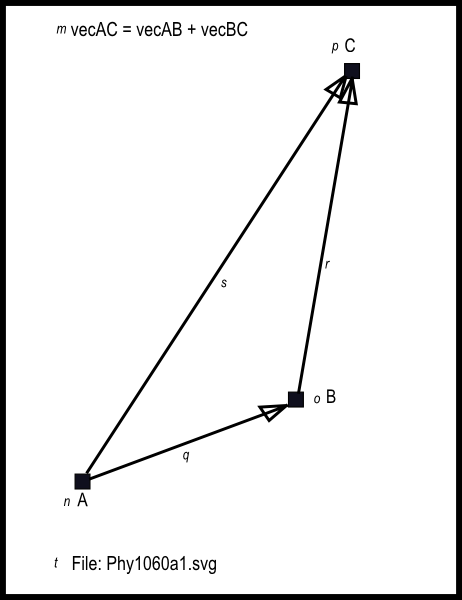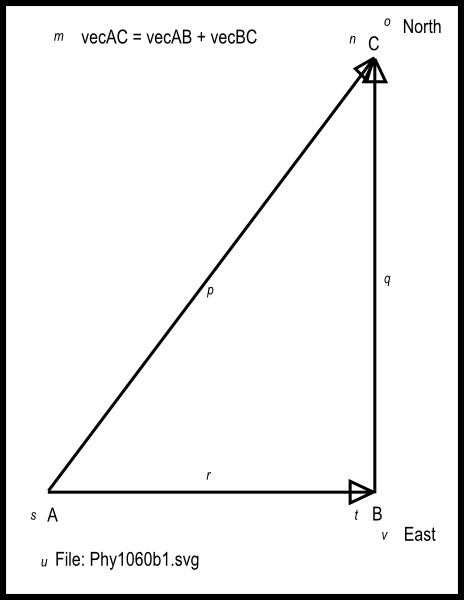| << Chapter < Page | Chapter >> Page > |
vecA, vecB, etc.
A graphic illustrating displacement
Figure 1 is a graphic that illustrates displacement.
Figure 1 - A graphic showing displacement.

The triangle shown in Figure 1 is a physical representation of the vector equation
vecAC = vecAB + vecBC
As usual, please ignore the lower-case letters scattered throughout the image, which were placed there for a purpose other than for use in this module.
What does this mean?
This vector equation does not mean that the algebraic sum of two sides of the triangle are equal to the third side. However, it does mean that the displacement vecAB togetherwith the displacement vecBC, have an effect that is equivalent to the single displacement vector vecAC.
Scalar addition and subtraction
When adding or subtracting scalars, you only need to take the magnitude values of the scalars into account and perform normal arithmetic using thosemagnitude values. An example would be to add 6 birds and 5 birds to produce a sum of 11 birds.
Vector addition and subtraction
However, when adding or subtracting vectors, you not only need to take the magnitude of the vectors into account, you also need to take the directions ofthe vectors into account.
A thought exercise
Figure 2 shows the vector diagram for a familiar example.
Figure 2 - Vector diagram for a familiar example.

Pretend that you are standing at point A in Figure 2 . Then pretend that you walk 30 meters due east and designate that location as point B.
Up to this point, your displacement can be represented by vecAB with a magnitude of 30 and anangle of zero (assuming that due east represents an angle of zero).
Walk 40 meters due north
Now pretend that you walk 40 meters due north and mentally designate the stopping point as C. Your displacement relative to point B can berepresented as vecBC with a magnitude of 40 meters and a direction of north or 90 degrees.
Displacement relative to point A
The interesting question is, what is your displacement relative to your starting point at A?
The displacement vector vecAC is the straight line from point A to point C, pointing in a direction from A to C. This vector is shown in the vector equation
vecAC = vecAB + vecBC
as the sum of the two vectors that describe the two segments of your journey from A to C.
Graphical addition of vectors
This process of connecting two or more vectors tail-to-head in sequence and then measuring the distance and direction from the tail of the first vector tothe head of the last vector is known as the graphical addition of vectors . The resulting vector (in this case vecAC) is known as the sum of the vectors thatmake up the sequence. (The resulting vector is often called the resultant.)
A 3-4-5 triangle
Recalling what we learned in an earlier module where I discussed a 3-4-5 triangle, the magnitude of the vector from A to C (the hypotenuse of a righttriangle with sides of 30 and 40) is 50 meters. You may also recall that the angle is approximately 53 degrees relative to the horizontal (east-west) line.
You should be able to measure the length of vecAC as well as the angle between that vector and the horizontal in Figure 2 and get reasonable agreement with the above.

Notification Switch
Would you like to follow the 'Game 2302 - mathematical applications for game development' conversation and receive update notifications?